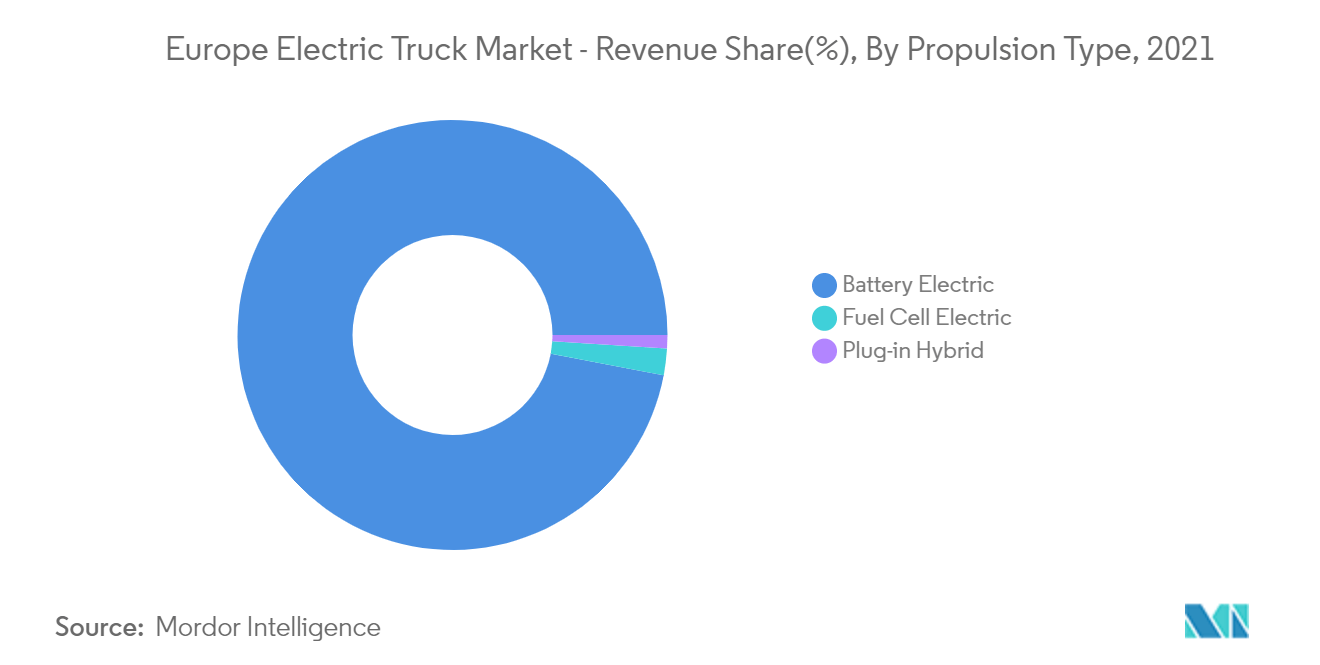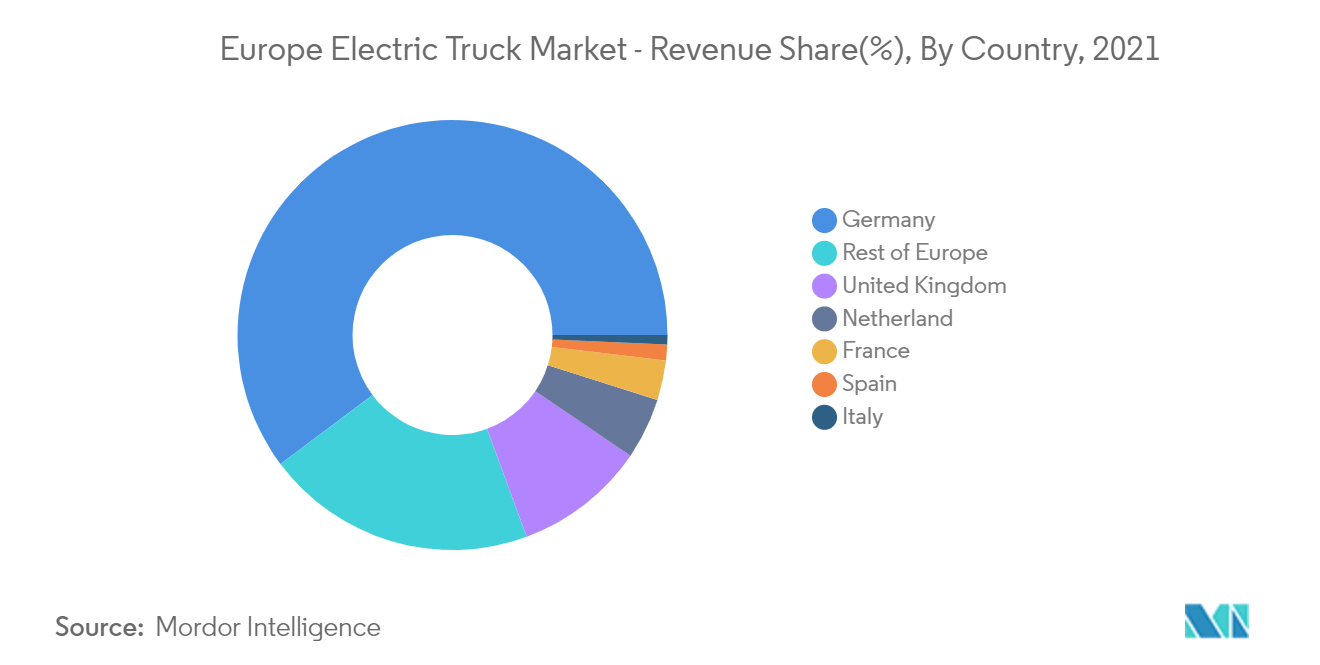Market Trends of Europe Electric Truck Industry
This section covers the major market trends shaping the Europe Electric Truck Market according to our research experts:
Battery Electric Truck Gaining Momentum
With the growing environmental concerns, governments and environmental agencies are enacting stringent emission norms and laws that may increase the manufacturing cost of electric drivetrains and fuel-efficient diesel engines during the forecast period.
Further, innovative government legislative policies focusing on spurring the penetration of electric trucks are expected to propel demand in the market during the forecast period. For instance, in February 2022, EU member states adopted new legislation which states that all EU member states have until 2023 to implement a new road toll system that gives big incentives for zero-emissions trucks.
- By May 2023, haulers operating zero-emissions trucks, i.e., battery electric or hydrogen, must be given at least 50% discounts on distance-based road tolls. Member states could opt to levy extra CO2-based charges on fossil fuel lorries instead or implement both measures. With road tolls costing haulers up to EUR 25,000 per truck annually, switching to zero-emissions vehicles may cut their overheads considerably.
- The new law also requires countries to apply truck air pollution charges from 2026. From 2024, new time-based road charges for trucks, less fair than distance-based tolling, may be restricted to limited circumstances. If time-based charges remain on major highways after April 2024, they must be varied according to the truck's CO2 emissions. Countries with toll roads under concession contracts may exempt these tolls from both CO2- and air pollution-based charging, but only until these contracts are renewed or substantially amended.
Green transportation is swiftly growing around the world, owing to which the goods transportation companies are also converting their existing fleet into electric propulsion-based vehicles. As the demand for electric trucks is growing, vehicle manufacturers are planning to launch more electric trucks. For instance,
- In June 2022, Swedish Company Scania introduced the "next level of battery-electric trucks (BEV)." With R or S sleeper cabs, the charging capability of the new e-trucks could be up to 375 kW, which means that an hour of charging will add some 270 to 300 km of range, and the power output level for a Scania 45 R or S is 410 kW (equivalent to some 560 hp).
Furthermore, in the wake of growing e-commerce and logistic activities, several companies operating across these sectors are widely depending on the trucking industry to transport goods across the nation. The demand for increases in shipping speed is fueled by huge online competitors, such as Amazon and other retailers that use their trucks and drivers as part of their e-commerce supply chain. For instance,
- In 2021, European e-commerce increased by 13 % to EUR 718 billion. The growth rate has remained stable, though it has risen slightly compared to 2020. According to the e-commerce Europe and euro commerce report 2022, Western Europe is, by far, the strongest region in B2C e-commerce turnover, holding 63% of the total turnover for 2021. Southern Europe follows in second place with just 16% of total turnover, Central Europe and Northern Europe come in third and fourth (10% and 9% respectively), and Eastern Europe (2%) in last place.
Based on the aforementioned factors, consistent launches of new electric trucks, growing investment in electric truck manufacturing, and the government's EV-supporting policies around the world are likely to drive the battery-electric truck market over the forecast period.

United Kingdom to Exhibit a Significant Growth Rate During the Forecast Period
The United Kingdom is expected to account for a significant share of the total sales of electric trucks during the forecast period. The United Kingdom is investing heavily in infrastructure development for electric mobility. It opened a new electric highway for hybrid electric trucks that overhead electric lines will power. It is constantly focusing on encouraging electric mobility and its policies are intended to push electric trucks into the country, expected to drive demand in the market.
Country's pollution laws are constantly changing, and diesel-powered trucks may be phased out entirely in the future. They would be replaced by electric counterparts, taking advantage of the electric construction vehicle industry.
Additionally, the British government has extended its electric van and truck subsidy scheme for another two years until 2025. New weight classes will be eligible for the subsidy beginning in April. According to the government, the subsidy is designed to help businesses convert their fleets in time and be "one step ahead" of the combustion engine's demise in 2030. Since the scheme's inception in 2012, plug-in van and truck grants have aided in the purchase of over 26,000 electric vans and trucks in the United Kingdom.
- By the end of 2021, the government had already cut the subsidy rates for electric vehicles. The large vans and small electric trucks were also subject to changes from April 1, 2022. The lower weight requirement for electric trucks rises from 3.5 to 4.25 tones, while the highest limit remains at 12 tones. These automobiles will be subsidized by 20% of the purchase price, up to a maximum of £16,000 per vehicle. Furthermore, the grant threshold for small electric trucks up to 16,000 pounds would be lifted from 3.5 tons to 4.25 tons. Electric trucks weighing up to 4.25 tons will be eligible for a £5,000 subsidy.
With the growing e-commerce sector, the demand from Logistics and delivery companies in the country has increased. To commercialize the market share, these companies started designing plans to deploy more electric commercial vehicles in their fleet in the coming years. For instance,
- In May 2022, Volvo Trucks and Deutsche Post DHL Group have agreed to collaborate to expedite the transition to zero-emission vehicles. DHL plans to accelerate its shift to big electric vehicles by deploying 44 new electric Volvo trucks on European routes. The planned order includes 40 Volvo FE and Volvo FL electric trucks, which will be utilized for package deliveries in urban areas. Electric trucks for longer routes are also included in the scope, and DHL has opted to start employing Volvo trucks for regional haulage, beginning with four Volvo FM Electric trucks in the United Kingdom.
- In December 2021, Tesco announced its plans to launch the first fully-electric HGVs used commercially in Britain to serve its distribution center in Wales. The vehicles can travel about 100 miles on a single charge, and these two 37-tonne trucks will transport goods from a rail freight terminal in Cardiff to the company's hub in Magor.
Therefore, in line with the abovementioned instances and developments associated with electric trucks in the country, the UK electric truck market is expected to capture a significant share in the overall market.


